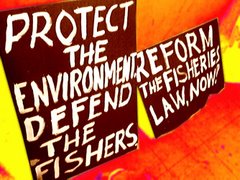
http://www.sunstar.com.ph/cebu/ta%C3%B1-unlike-any-worldwide
Tañon unlike any worldwide
By Liberty A. Pinili
THERE’s another reason to protect Tañon Strait.
American marine biologist Kent Carpenter said Tañon Strait, the narrow stretch of sea between the southern end of Cebu and Oriental Negros, may offer answers on why and how certain marine organisms are resilient to climate change.
Aside from this, Tañon Strait’s geology can be considered the “most unique in the world” as it was formed when two islands—Cebu and Negros—which used to be far from each other, moved closer.
Sun.Star accepts donations for victims of Typhoon Ondoy
“Over 55 million years ago, Cebu started to move from where Papua New Guinea is now while Negros came from the opposite direction. The strait must have accumulated an extremely unique group of marine organisms,” said Carpenter, who has studied the Philippines’ marine waters for about 30 years and has declared the seas around the Visayas to be the richest in biodiversity.
He said that during the Ice Age, the Tañon Strait was cut off from other seas so organisms in the area must have evolved differently.
Too special
“It’s too special a place to tamper with,” he said, reacting to plans to explore oil in the Tañon Strait. He added that the strait needs to be considered as a national heritage.
He said he plans to conduct a study on the species of marine organisms in the strait. He plans to start the study within a year or two.
Carpenter noted that while the Tañon Strait has been declared a national protected area, enforcement of protection laws has been wanting.
Still, he commends the Philippines for having the most number of marine protected areas in Asia. In Cebu, he cited the marine protected areas (MPAs) off Gilutongan Island in Cordova, Sam-boan, Sumilon (Oslob) and Moalboal.
“But only a small percentage of Philippines MPAs are well-managed. It’s not perfect but I’m hopeful that some environments will be preserved over a long period of time,” he said.
He stressed the importance of establishing a network of MPAs and strict enforcement of laws against destructive fishing practices.
Economic sense
He said communities and local governments tasked to manage MPAs should use the fees collected from divers to finance maintenance and protection measures.
He stressed that protecting the country’s marine environment also makes economic sense with long-term benefits.
Carpenter was in Cebu last week to talk to students in different universities about the importance of protecting the biological diversity of marine life in the Philippine seas.
His talks with Cebu students were part of the Coral Triangle Initiative, a joint project of six countries (Indonesia, Malaysia (Sabah), Papua New Guinea, Philippines, Solomon Islands and Timor-Leste), their neighbors (Australia, Fiji, New Caledonia and Vanuatu) and partners, including the United States, United Kingdom and the World Wildlife Fund.
The initiative aims to come up with national and regional (within the Coral Triangle) action plans to protect and manage the marine diversity in the Coral Triangle.
Scientists report that the Coral Triangle is home to more than 500 species of corals and 3,000 fish species. It holds 53 percent of the world coral reefs and has the greatest extent of mangrove forest than any region in the world.
Carpenter is one of the scientists assessing the threatened species list for the Coral Triangle area.
His visit to Cebu was part of the assistance pledged by the US to the Coral Triangle Initiative.
The United State’s Bureau of East Asian and Pacific Affairs and the US Agency for International Development have committed a total of $4.35 million to the initiative.
The initiative involves strategies to enhance the capabilities of seascapes; an ecosystem approach to fisheries management, where fisherfolk are given alternative livelihood; establishment and protection of marine protected areas; climate change adaptation; and threatened species assessment.





No comments:
Post a Comment